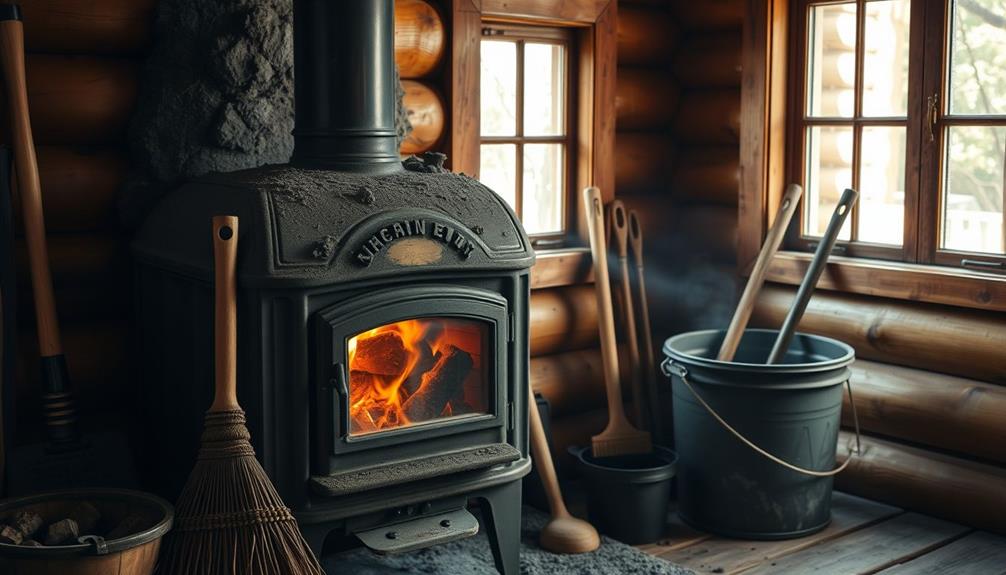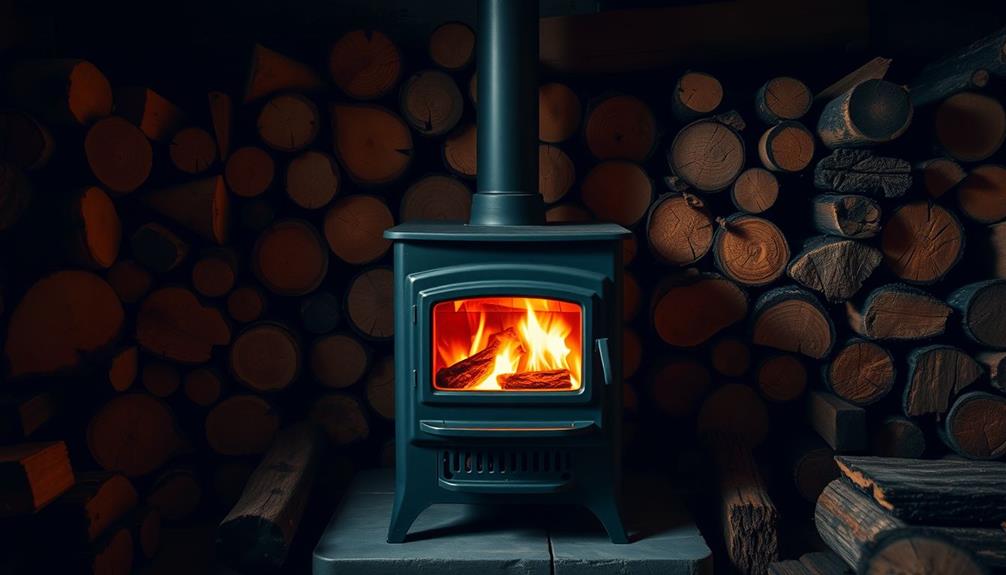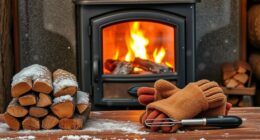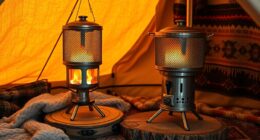To clean your wood stove and chimney safely, start by ensuring the stove is cold. Wear protective gear like goggles and masks, and use a sturdy ladder to reach the chimney. Remove ashes from the stove, then detach the chimney cap for access. Use a wire brush to scrub away creosote buildup, checking for any leftover debris. Seal off the fireplace with plastic to contain soot. Inspect your tools for safety and effectiveness. Regularly clean your chimney to prevent fire hazards, and there's more to discover about maintaining your wood stove efficiently to keep your home safe and warm.
Key Takeaways
- Ensure the wood stove is completely cool before cleaning to prevent burns and injuries.
- Regularly inspect and clean your chimney at least once a year to prevent creosote buildup and fire hazards.
- Use a wire chimney brush and shop vacuum for effective creosote removal and debris cleanup.
- Wear protective gear, including goggles and dust masks, to safeguard against soot and particles during cleaning.
- Consider hiring a professional chimney sweep for thorough inspections and compliance with safety standards.
Importance of Chimney Cleaning
Cleaning your chimney is vital for a safe and efficient wood stove operation. Regular chimney cleaning helps you prevent hazardous creosote buildup, which can lead to dangerous chimney fires that may reach temperatures of up to 2,000°F.
Additionally, maintaining clean ventilation is important for ideal air quality and safety in your home, as neglecting this can contribute to health issues, similar to the effects of allergies as potential triggers for respiratory problems. By keeping your chimney clean, you not only protect your home but also enhance the efficiency of your heating system. Proper ventilation and ideal airflow result in lower energy bills, making your wood stove operation more cost-effective.
It's recommended to schedule annual inspections and cleaning, especially if you use your wood-burning fireplace frequently. If you're burning wet firewood, you might need to arrange for mid-winter cleanings to guarantee safe operation.
This maintenance practice isn't just about efficiency; it also provides peace of mind by preventing hazardous situations, such as carbon monoxide buildup.
While you can attempt some chimney cleaning yourself, hiring a professional chimney sweep is often the best choice. They've the expertise and tools to guarantee the job is done right, keeping your chimney safe and efficient.
Prioritizing chimney cleaning is a small effort that yields significant safety benefits for you and your family.
Signs Your Chimney Needs Attention
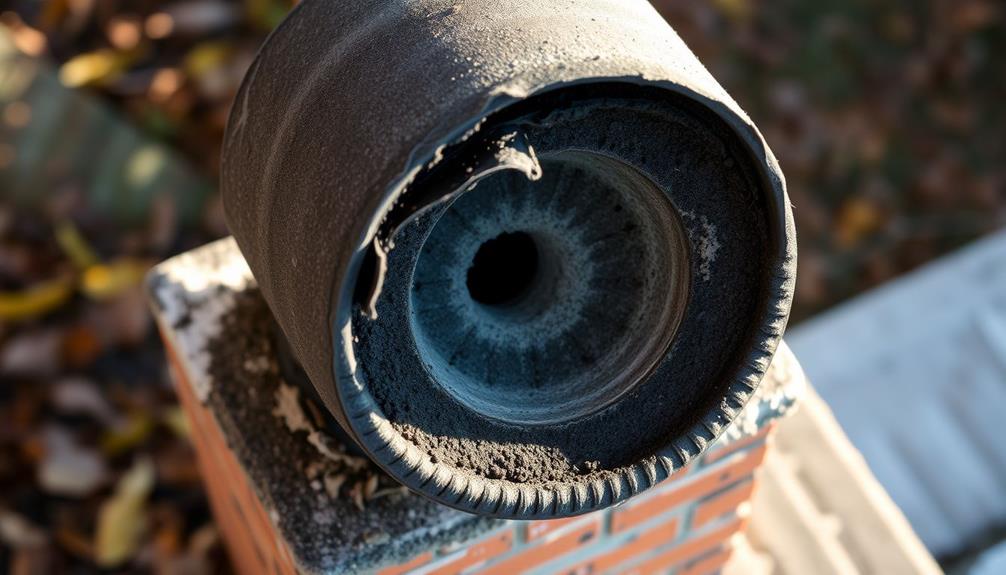
When you notice signs like persistent smoky odors or poor draft from your wood stove, it's time to pay attention to your chimney's condition. These indicators can point to serious issues, such as chimney fires or creosote buildup, which can pose significant risks to your home.
| Sign of Attention | Possible Cause | Action Required |
|---|---|---|
| Smoky odors | Inadequate ventilation | Inspect for blockages |
| Poor draft | Airflow obstruction | Clean your chimney |
| Creosote buildup > 1/8" | Excessive soot accumulation | Schedule a cleaning |
| Visible debris in flue | Blockage or obstruction | Immediate inspection |
If you notice any of these signs, don't hesitate to act. A creosote buildup exceeding 1/8 inch is particularly dangerous and can lead to chimney fires. Slow-burning fires may indicate airflow obstruction, which can hinder your appliance's performance. Regular inspections and cleanings can prevent these issues and guarantee your chimney operates efficiently and safely. Remember, maintaining your chimney is key to protecting your home and family.
Frequency of Chimney Cleaning
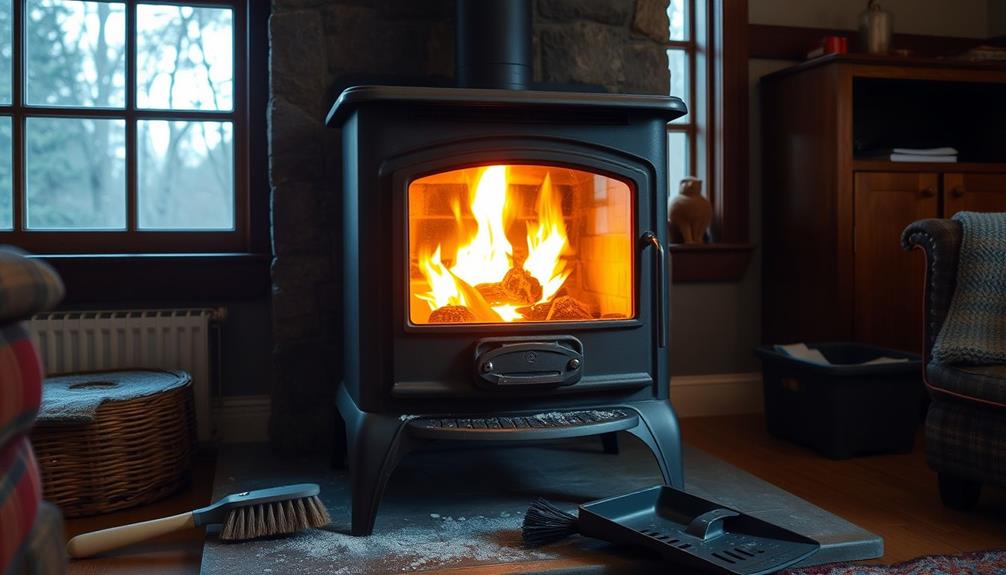
You need to stay on top of your chimney cleaning to avoid dangerous creosote buildup. Regular inspections can help identify issues early on, as neglecting this task poses serious safety risks, including chimney fires.
Ideally, you should inspect and clean your wood-burning fireplace annually, but if you use it frequently, you might need to clean it more often. Seasonal maintenance can also help determine the best times for cleaning, especially when the fireplace isn't in use.
Consider investing in a reliable safety equipment to guarantee your cleaning process is secure.
Signs You Need Cleaning
Recognizing the signs that your chimney needs cleaning is important for maintaining safety and efficiency. One major red flag is creosote buildup exceeding 1/8 inch. This thick residue is highly flammable and can lead to a chimney fire if not addressed promptly.
If you notice persistent smoky odors in your home, it's time to investigate; this could indicate issues with your chimney that require immediate attention. Additionally, using heating appliances like the Englander 10-Cpm Corn Wood Pellet Stove may demand more frequent chimney inspections due to their high-efficiency ratings and unique combustion processes.
Another sign to watch for is a poor draft or slow-burning fires. These symptoms often suggest airflow obstructions, which can hinder efficiency and safety. Additionally, if you see excessive soot accumulation, it's a clear indication that you should clean the chimney soon.
Ignoring these warning signs can result in decreased efficiency in your heating appliances, as well as potential fire hazards. For those using wood-burning fireplaces, it's important to stay vigilant. Regular inspections and cleaning are essential, especially for those burning wood more than three times a week.
Recommended Cleaning Frequency
Cleaning your chimney regularly is vital for safety and efficiency. If you have a wood-burning fireplace, it's important to inspect and clean it at least once a year. This helps prevent hazardous creosote buildup that can exceed 1/8 inch, which poses a risk for chimney fires.
Additionally, it's significant to think about hiring a professional home cleaning service to guarantee the job is done effectively and safely. If you frequently burn wood—more than three times a week—you may need to schedule a cleaning every few months. This guarantees that your chimney remains safe and efficient, reducing the chances of creosote accumulation.
For those who only use their fireplace seasonally, you should still keep an eye on your cleaning frequency, especially if you use wet firewood. Wet wood increases creosote buildup and can affect how well your chimney functions.
Even if you have gas or oil appliances, remember that they also require annual inspections to maintain safety, though they present a lower risk for creosote.
Regular chimney cleaning not only minimizes fire hazards but also enhances your heating system's efficiency by maintaining ideal airflow. Stay vigilant about your chimney maintenance to guarantee a safe and cozy environment in your home.
Seasonal Maintenance Tips
As the seasons change and temperatures drop, it's vital to adjust your chimney cleaning routine accordingly. For wood-burning fireplaces, an annual inspection and cleaning is essential to prevent hazardous creosote buildup exceeding 1/8 inch.
Additionally, taking the time to understand the benefits of diversifying investments can provide peace of mind as you prepare for winter. If you use your fireplace frequently—more than three times a week—you might need to clean a chimney more often. This extra attention helps maintain safety and efficiency.
During the winter months, if you're burning wet firewood, be prepared for increased creosote accumulation. In this case, consider scheduling an additional cleaning mid-winter. It's better to be proactive than to risk a chimney fire.
For gas and oil appliances, while the risk of creosote buildup is lower, annual inspections are still necessary to guarantee they're functioning safely.
The best time to clean a chimney is during the spring or summer when your fireplace isn't in use. This seasonal maintenance can prevent buildup and guarantee your chimney is ready for the colder months ahead.
Using the right cleaning method will keep your fireplace safe and efficient, so don't overlook this important task!
Types of Chimney Inspections
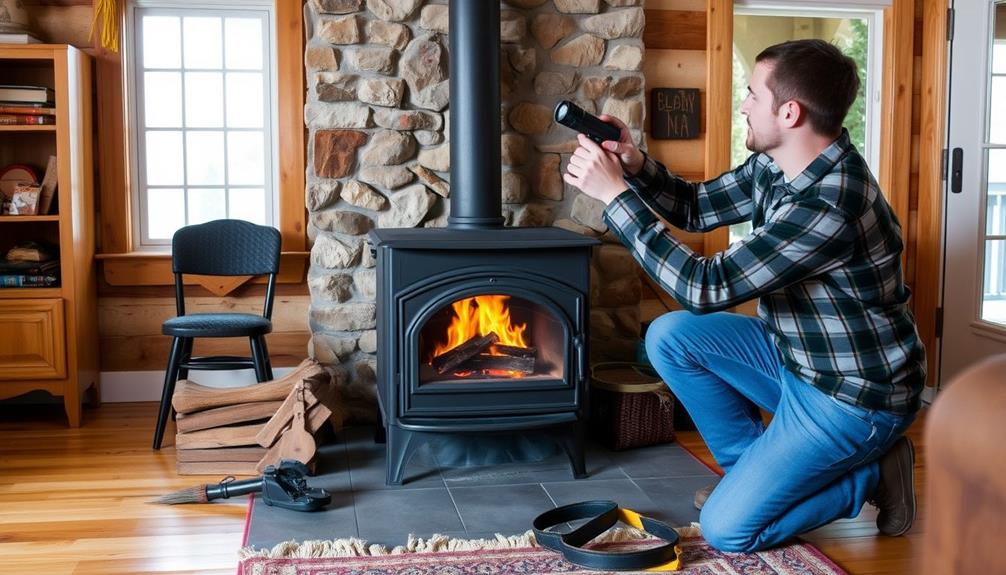
There are three main types of chimney inspections, each serving a specific purpose to guarantee your wood stove operates safely and efficiently.
Regular maintenance, similar to dog grooming needs, helps maintain optimal performance and longevity of your wood stove system.
The first is the Level 1 Inspection, which includes a basic visual check of the chimney. This is recommended annually for well-maintained systems to confirm no immediate hazards, like creosote buildup, are present.
Next, there's the Level 2 Inspection. This is more thorough and necessary when you make changes to the system or if malfunctions occur. It allows chimney sweeps to examine hidden areas that might be problematic, confirming all components are functioning correctly.
Lastly, the Level 3 Inspection is extensive and is required when there are suspected serious hazards, such as structural damage or blockages. This type is essential for preventing dangerous situations that could arise from neglecting your chimney.
Regular chimney inspections help identify potential issues before they escalate into costly repairs or safety hazards.
DIY Chimney Cleaning Steps
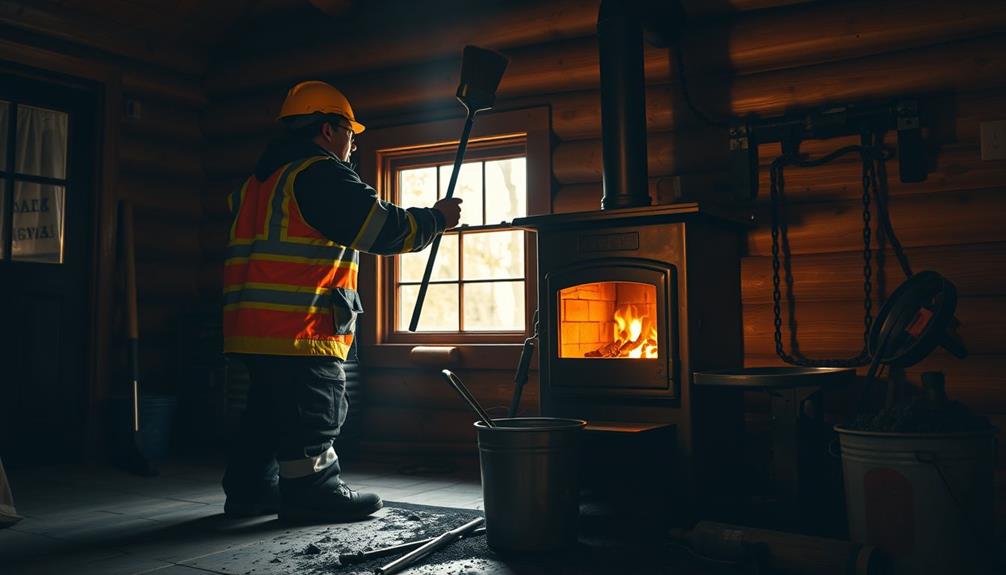
Before you start cleaning your chimney, make certain you've taken the necessary safety precautions.
Proper indoor air quality is vital, as air purifiers reduce allergens, which can be beneficial while you work.
Gather your essential tools like a wire brush and protective gear to stay safe during the process.
Let's walk through the step-by-step cleaning procedure to guarantee your chimney is in top shape.
Safety Precautions First
Cleaning your wood stove and chimney safely is crucial for preventing accidents and guaranteeing a smooth process. Start by following these important safety precautions to keep yourself and your home protected.
| Safety Step | Description | Importance |
|---|---|---|
| Confirm Stove is Cold | Wait until the wood stove is completely cold to the touch. | Prevents burns and injuries. |
| Wear Protective Gear | Use goggles and a dust mask while cleaning. | Shields against soot and creosote. |
| Use a Sturdy Ladder | Secure a sturdy ladder with a spotter when accessing the roof. | Guarantees safety at heights. |
| Seal Fireplace Front | Use a plastic liner and duct tape to seal the fireplace. | Contains debris and soot. |
| Inspect Cleaning Tools | Regularly check cleaning tools for wear and suitability. | Maintains safety and effectiveness. |
Essential Cleaning Tools
With safety precautions in place, you'll want to gather the right tools for cleaning your wood stove and chimney effectively. Start with a wire chimney brush, which is essential for removing creosote buildup.
Research shows that regular maintenance of your chimney is vital to prevent fire hazards, similar to how regular vet check-ups are essential for maintaining your cat's health cat health and nutrition. These brushes come in various sizes to fit different flue dimensions, ensuring a thorough clean.
You'll also need a sturdy ladder to access the chimney safely from the roof, and it's a good idea to have a partner assist you while you work at heights.
Next, invest in a shop vacuum—preferably an industrial one—to clean up soot and creosote after you've scrubbed the chimney. This helps prevent debris from spreading throughout your home.
Don't forget your protective gear, including goggles and a dust mask, to shield yourself from dust and particles during the process.
Additionally, consider having drop cloths on hand to protect your floors and surfaces from soot. A metal tool for scraping and a bucket for collecting debris can also be useful.
Step-by-Step Process
To guarantee a safe and effective chimney cleaning, start by making certain your wood stove is cold to the touch, which usually means waiting several hours after your last fire.
Once it's cool, remove any ashes using an ash bucket and shovel. This prepares the stove for a thorough inspection and cleaning. It's also important to verify that any flue pipes are clear of obstructions, as this can help maintain proper airflow and prevent chimney fires.
Maintaining a clean chimney is similar to airless paint sprayer maintenance, where regular upkeep is vital for peak performance.
Next, you'll want to detach the chimney cap. If you're up on the roof, use a chimney brush to scrub the chimney flue's walls, or head to the fireplace for the same task.
Focus on removing creosote buildup, as it can be a fire hazard.
After scrubbing, be sure to reattach the chimney cap securely.
Take a moment to check for any debris or tools left behind in the chimney or stove area. This guarantees both safety and cleanliness.
Essential Tools for Cleaning
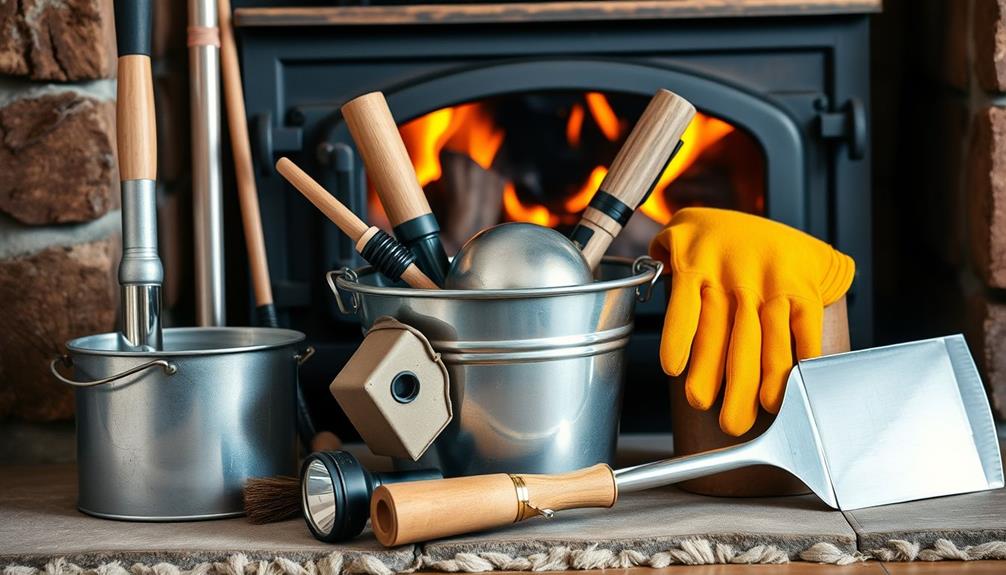
What tools do you need to effectively clean your wood stove and chimney? First and foremost, you'll need a wire chimney brush, which is fundamental for removing creosote buildup. This brush is specifically designed for the task and works best with the right cleaning methods.
A vacuum designed for soot and debris cleanup is also important for maintaining a tidy workspace, and you might want to take into account options that feature advanced filtration systems for improved air quality while you clean. To find budget-friendly vacuum cleaners that can handle such tasks, check out user reviews for the best options.
To inspect the flue for any blockages, grab a flashlight and a mirror. These tools will help you identify areas that require attention, ensuring nothing is missed during your cleaning.
Don't forget your protective gear! Goggles and a dust mask are essential to protect yourself from inhaling soot and debris while you work. If you plan to clean from the top down, a sturdy ladder is necessary, along with a spotter for added safety.
Additionally, drop cloths can help protect your surfaces, while a bucket is handy for collecting debris. A metal tool will come in handy for scraping off any stubborn creosote deposits.
With these fundamental tools, you'll be well-equipped to clean your wood stove and chimney effectively.
Safety Precautions to Consider

Cleaning your wood stove and chimney can be a rewarding task, but safety should always come first. Before you start, make sure your wood stove is completely cold to the touch to prevent burns or accidental ignition. Wearing protective gear like goggles and a dust mask is essential to guard against soot and debris during the cleaning process.
Here are some important safety precautions to keep in mind:
| Safety Precautions | Description |
|---|---|
| Check Equipment | Inspect all tools and equipment for safety and functionality before use. |
| Secure the Fireplace Opening | Use a tarp or plastic liner to contain soot and debris, minimizing mess in your home. |
| Ladder Safety | Utilize a sturdy ladder and have a partner present when accessing the roof for cleaning. |
Deciding whether to clean the chimney yourself or hire a professional can impact safety. If you choose to tackle the chimney yourself, follow all safety protocols diligently. Remember, prioritizing safety guarantees a successful cleaning experience and protects you from potential hazards.
Professional Chimney Cleaning Benefits
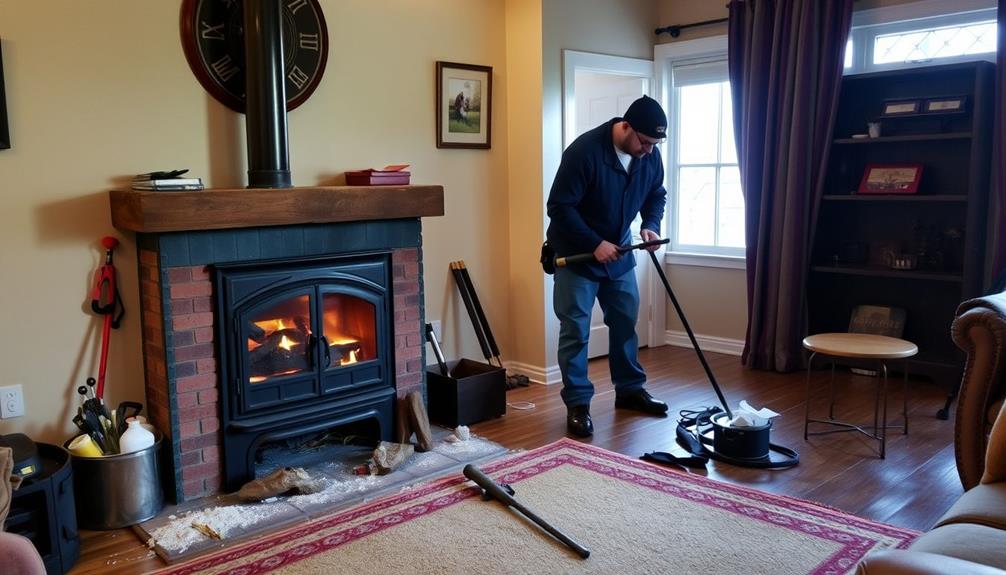
When you hire a professional chimney cleaner, you're tapping into their expertise and experience to keep your home safe.
They follow safety compliance standards and conduct a thorough inspection process that guarantees your chimney operates efficiently.
This proactive approach not only minimizes risks but also saves you money in the long run.
Expertise and Experience
Opting for a professional chimney sweep not only saves you time but also guarantees your wood stove and chimney are in expert hands.
These certified professionals possess the expertise needed to tackle hazardous creosote buildup effectively, which is essential for preventing dangerous chimney fires. They utilize specialized equipment and techniques that far exceed what most homeowners can achieve on their own.
When you hire a professional, you're not just getting a clean chimney; you're also receiving a thorough inspection.
These experts can identify hidden issues like damaged liners or blockages before they escalate into costly problems. Their knowledge of safety protocols guarantees that your chimney isn't only clean but safe for continued use.
While the average cost for professional chimney cleaning ranges from $129 to $380, this investment is minor compared to the potential expenses associated with chimney fires or extensive repairs.
Regular maintenance from certified professionals can extend the lifespan of your chimney and heating appliances, guaranteeing they operate efficiently and safely.
Safety Compliance Standards
Keeping your chimney in top shape isn't just about aesthetics; it's also about safety compliance. When you hire professional chimney services, you're guaranteeing that your chimney and wood stove meet essential safety standards. Certified chimney sweeps are trained to identify and mitigate risks, greatly reducing the chances of hazardous situations during cleaning.
Here are some benefits of engaging professionals for your chimney maintenance:
- Expert Knowledge: They understand the intricacies of chimney systems and comply with NFPA guidelines.
- Specialized Equipment: Certified chimney sweeps use tools that minimize damage to your chimney structure while guaranteeing thorough cleaning.
- Hidden Issue Detection: Professionals can spot cracks or blockages that may pose safety hazards if ignored.
- Compliance Assurance: Hiring experts guarantees that your chimney meets local building codes and insurance requirements.
- Liability Protection: By adhering to safety standards, you protect yourself from potential liabilities in case of a fire.
With certified chimney sweeps, you can rest easy knowing your chimney is in compliance and your home is safe. Prioritizing professional cleaning is a smart investment in your safety and peace of mind.
Thorough Inspection Process
A thorough inspection process is essential for maintaining the safety and efficiency of your chimney and wood stove. When you hire a professional chimney cleaning service, they conduct a detailed Level 2 inspection. This inspection goes beyond a basic visual check, identifying hidden issues like cracks or blockages that could lead to dangerous situations such as chimney fires or carbon monoxide buildup.
Certified professionals use specialized equipment and their expertise to guarantee compliance with safety standards. This not only provides you peace of mind but also helps catch potential problems early.
Regular inspections can extend the lifespan of your chimney and heating appliances by pinpointing maintenance needs before they escalate into costly repairs. Experts recommend scheduling a Level 2 inspection after any major changes or malfunctions in your system.
These thorough assessments help maintain ideal airflow and heating efficiency while greatly reducing the risk of dangerous creosote buildup. By utilizing professional services, you guarantee that your chimney is cleaned and inspected correctly, safeguarding your home and family from hazards associated with neglecting proper chimney maintenance.
Preventing Creosote Buildup
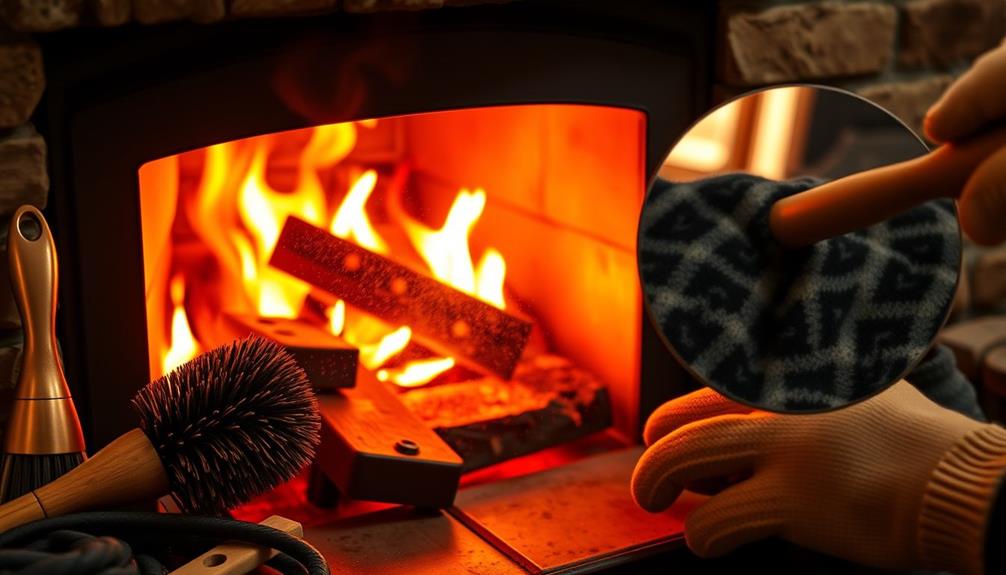
Preventing creosote buildup is essential for maintaining a safe and efficient wood stove. By taking proactive measures, you can enjoy your wood stove without the worry of hazardous conditions.
Here are some effective strategies to minimize creosote accumulation:
- Burn well-seasoned wood: Use wood with less than 20% moisture content to guarantee a cleaner burn.
- Clean your chimney regularly: Aim for annual cleanings, or more often if you use your stove frequently, to avoid excessive creosote buildup.
- Utilize a high-efficiency wood stove: These stoves promote hotter, more complete burns, reducing creosote formation.
- Maintain ideal airflow: Keep your chimney and flue clear of blockages to enhance combustion efficiency and limit creosote production.
- Schedule regular inspections: Hire a professional chimney sweep to catch any early signs of creosote buildup before they become serious issues.
Maintenance Tips for Wood Stoves
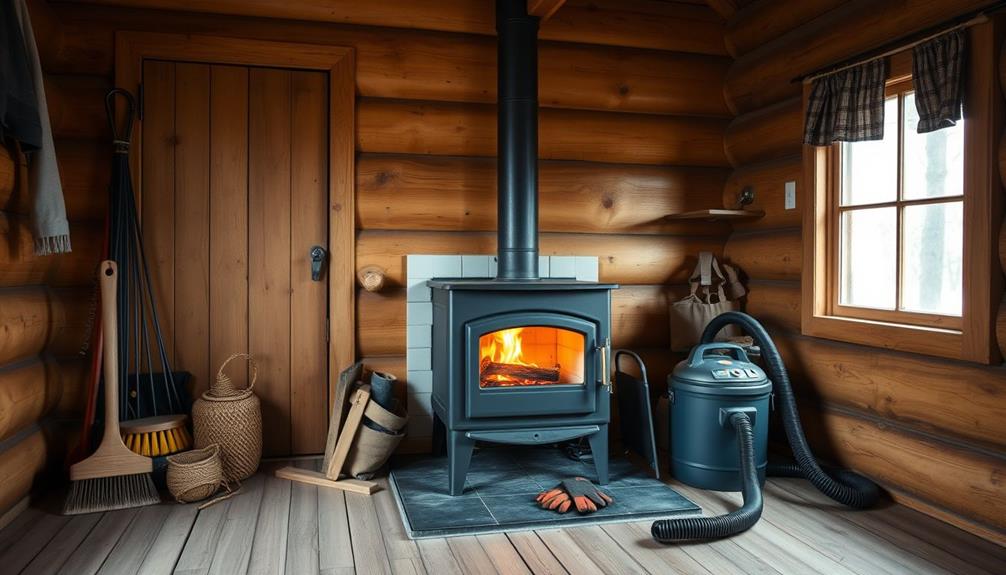
Regular maintenance is key to guaranteeing your wood stove operates efficiently and safely. To keep your wood stove in top condition, follow these essential maintenance tips:
| Task | Frequency | Benefits |
|---|---|---|
| Empty ashpan and ashtray | After each use | Prevents airflow obstruction |
| Inspect for damage | Monthly | Guarantees all components function well |
| Deep clean your stove | Annually | Prevents creosote buildup in chimney |
Make it a habit to clean your wood stove regularly. Always empty the ash pan and ashtray to improve airflow and efficiency. Monthly inspections for signs of wear will help you catch issues early. When it comes to the stove's window, use a specialized cleaner to maintain visibility while burning.
Additionally, deep cleaning your wood stove and chimney at least once a year is vital. This will help prevent dangerous creosote buildup in the chimney interior, reducing the risk of chimney fires. Don't forget that wood ashes can be used as a natural fertilizer in your garden, adding valuable nutrients. Following these maintenance tips will guarantee your wood stove remains safe and efficient.
Frequently Asked Questions
How Often Should You Clean Your Chimney With a Wood Stove?
You should clean your chimney annually if you use your wood stove regularly. If you burn wood more than three times a week, consider more frequent cleanings to prevent dangerous creosote buildup and guarantee safety.
Can You Clean a Wood Stove Chimney From the Bottom Up?
Did you know that nearly 25,000 chimney fires occur annually in the U.S.? Yes, you can clean a wood stove chimney from the bottom up. Just remember to use the right tools and techniques for safety.
How Do You Remove Creosote From a Wood Stove?
To remove creosote from your wood stove, start with a cold stove. Use a wire brush to scrape buildup, empty the ash pan regularly, and vacuum any debris after cleaning to maintain efficiency.
How Do You Know When Your Chimney Needs Sweeping?
When smoke signals trouble, your chimney's calling for help. If you notice creosote buildup, persistent odors, poor drafts, or visible debris, it's time to act. Don't wait—sweep it clean before danger strikes.
Conclusion
Cleaning your wood stove and chimney isn't just about keeping things tidy; it's essential for safety. Did you know that over 25,000 chimney fires occur in the U.S. each year? By staying proactive with your cleaning routine and maintenance, you can greatly reduce the risk of these dangerous fires. So, grab your cleaning tools, follow the steps outlined, and enjoy the warmth of your wood stove knowing you've taken the right precautions. Stay safe and cozy!

